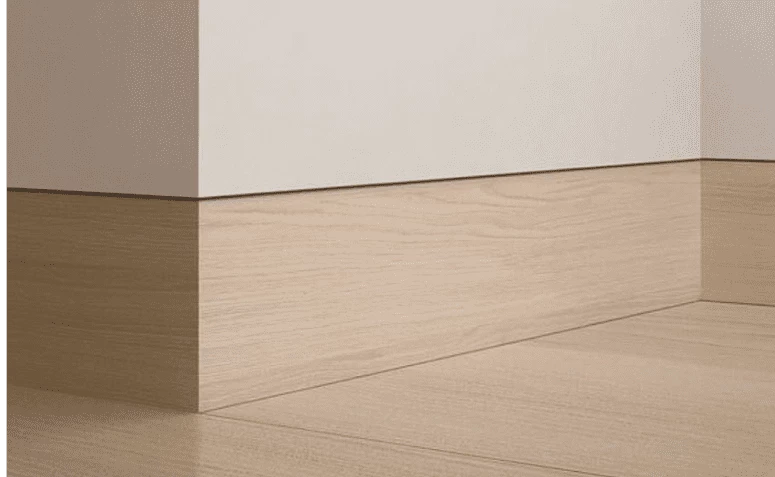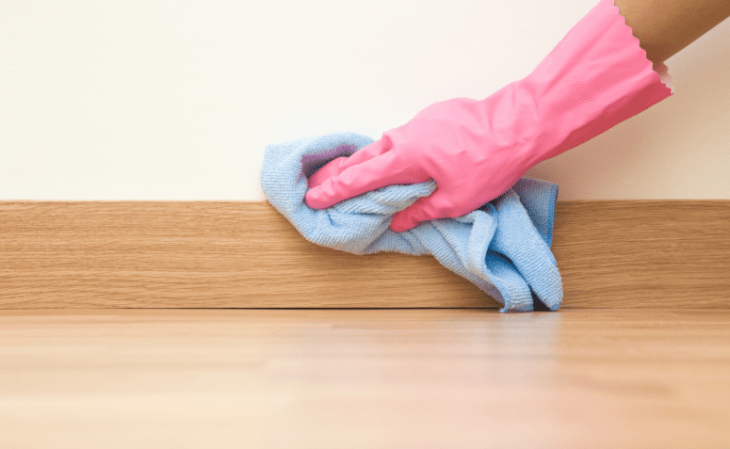Table of contents

Inlaid baseboards are a type of finish that has been gaining more and more space. Besides uniting beauty and versatility, it gives functionality to the environment. This way, it can go in several environments, for example, from the dining room to the bathroom. We called an architect to talk about the advantages and how to put inlaid baseboards. Check it out:
What is the Recessed Baseboard
Built-in baseboard is a finish made of flooring and, as the name implies, it is built into the wall. That is, during installation, the baseboard is placed close to the plaster. In this way, the baseboard stays close to the wall. That is, it does not have an edge or relief in relation to the plaster.
This type of decoration does not have a difference in level with the wall. In this way, it gives the impression of continuity to the construction. However, not all types of floors are suitable for this type of plinth. For example, cold floors are more suitable, such as porcelain tiles or ceramic tiles.
5 advantages of recessed baseboards to embrace this architectural trend

To talk about the advantages of using baseboards placed inside the wall, we called Architect and Urban Planner Duda Koga, from PRC Empreendimentos:
- Sense of spaciousness: The finishing between the floor and the wall is done in such a way that it is uniform. However, for this, the same material must be used for the floor and the baseboard.
- Better use of space: In addition to the centimeters that are gained in relation to the conventional baseboard, the furniture can be closer to the wall.
- Modern trend: skirting boards up to 30 cm high can be used to create a greater perception of depth in the room. In this case, it is interesting that the wall covering have a different shade from the skirting board so that the impact is guaranteed.
- Continuous finishing: with the floor covering being different from the skirting board covering, a trim can be made between the two surfaces. This creates an "L"-shaped effect, which creates a sense of continuity.
- No mess: The best advantage is that the recessed baseboard does not accumulate dirt on the piece.
These tips from the architect and urban planner Duda Koga show how versatile the baseboard placed inside the wall is. In addition, this type of decoration also leaves the environment with a more contemporary look.
See_also: PET Bottle Vase: 65 ideas and step-by-step for sustainable decorationHow to lay inlaid baseboards to renew any environment
The architect and urban planner Duda Koga also listed seven steps on how to put inlaid baseboards. Among these steps are tips on how to have the perfect finish in the next remodel. So, check out the steps to adhere to this type of contemporary decoration:
- It is necessary to check the desired height of the baseboard before application. This is because you must leave the space for it without plastering. However, if the work is a remodel, you must create an opening in the wall, remove the existing plaster, and leave a space so that the baseboard can fit into it and face the wall.
- In addition, confirm whether the wall is structural or just for closing, so if it is structural, usually in concrete blocks, the wall should not be disturbed, i.e. it is not possible to create an opening in the wall during renovation and apply the baseboard inside the wall.
- Mash the piece to the proper thickness so that the baseboard fits into the wall. In this way, it will be embedded.
- Follow the floor layout so that the grouts, both on the floor and on the baseboard, are aligned. To do this, the use of spacers is recommended.
- Apply grout in the same shade as the floor grout, so that the finish is homogeneous.
- Put crepe tape on the entire length of the recessed baseboard when painting the wall, because this model of baseboard requires greater care when it comes to finishing.
- If you do not feel confident, hire a qualified professional, since the finish between the baseboard and the wall requires more attention and care.
The baseboard is part of the floor when remodeling or building a room, so if you are doing it all yourself, see also how to lay flooring.


